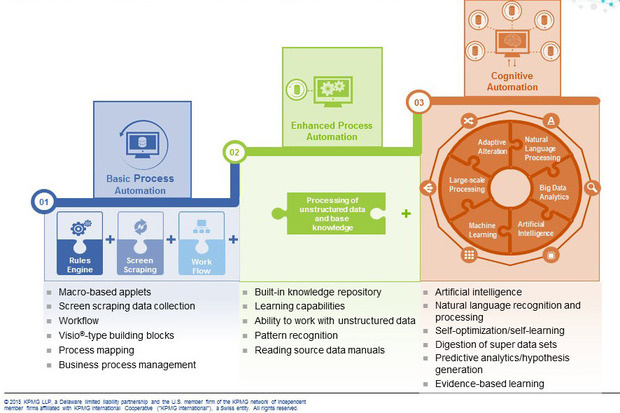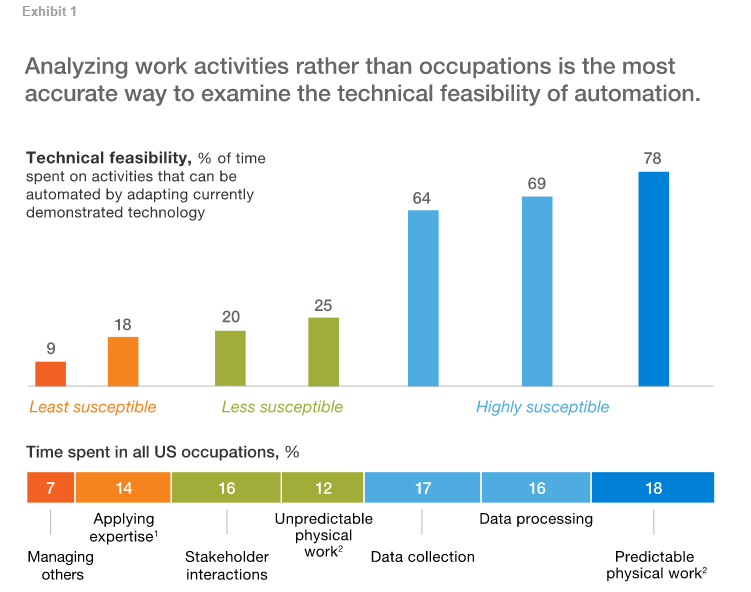Why Enterprises Struggle with IT Automation & Where to Begin
Gartner predicts that by 2017, 75 percent of enterprises will have more than four diverse automation  technologies within their IT management portfolios, up from less than 20 percent in 2014. The driving factor behind this trend is that automation leverages accountability, efficiency, and predictability while diminishing cost, variability, and risk. If this technology generates very lucrative results, why aren't more organizations further down the automation path, you may ask. Well, because even enterprises often struggle with how and what to automate, and where to begin. Milind Govekar, Research Vice President at Gartner, said IT organizations need to move from opportunistic to systematic automation of IT processes: “Most current use of automation in IT involves scripting,” said Mr. Govekar. “Scripts are more fragile than agile. What you end up with is disconnected islands of automation, with spaghetti code throughout the organization when what you need is a systematic, enterprise-wide lasagne.” Therefore, this article will discuss what to automate and where to begin.
technologies within their IT management portfolios, up from less than 20 percent in 2014. The driving factor behind this trend is that automation leverages accountability, efficiency, and predictability while diminishing cost, variability, and risk. If this technology generates very lucrative results, why aren't more organizations further down the automation path, you may ask. Well, because even enterprises often struggle with how and what to automate, and where to begin. Milind Govekar, Research Vice President at Gartner, said IT organizations need to move from opportunistic to systematic automation of IT processes: “Most current use of automation in IT involves scripting,” said Mr. Govekar. “Scripts are more fragile than agile. What you end up with is disconnected islands of automation, with spaghetti code throughout the organization when what you need is a systematic, enterprise-wide lasagne.” Therefore, this article will discuss what to automate and where to begin.
Why Do Enterprises Struggle?
One of the most common mistakes that enterprises are making is automating the application release but not the components behind it. As a result, unsurprisingly, the system breaks down and the value proposition of automation has never been received by the organization.
Another mistake made by even large organizations is automating for the sake of automation. The company’s objectives should be the first consideration while choosing activities that will be automated. Therefore, identifying ways that automation supports objectives such as powering a constantly ready business or converging machine, and user data to enable real-time business decisions, is the most prominent component of this project. Organizations also should make sure that desired business outcomes and objectives from automation process are identified and fully grasped by all the stakeholders of the project.
Determine what it is costing to do the task manually, and how much it would cost to automate that effort. Then determine how much money will be saved, perhaps in time or other resources, by automating that task. Although calculating return on investment (ROI) of automation sounds very straight forward, it can get tricky when you do not consider how much it will cost to maintain your automation and any automation tool isn't a set-it-and-forget-it process.
Organizations are also struggling due to the lack of strategy. “The more you standardize the environment before automating it further, the better placed you will be,” said Mr. Govekar. “Don’t automate the mess – get rid of the mess first.” A finely defined strategy is a must. First things first, the executives need to identify where automation could be applicable in their own organizations and from there put a strategy in place, to migrate to new business processes powered by automation. Mapping out potential automation activities within companies is essential to identify and prioritize the potential processes and activities that could be automated. The technology should be future-proof as well. Therefore, decision makers should make sure they understand the data and automation technologies on the horizon today.

Image: KPMG, LLP
What to automate? Where to begin?
According to the consultancy McKinsey, to determine what activity will be automated, there are five factors involved: technical feasibility; costs of automating; the relative scarcity, skill, and cost of workers who might otherwise do the activity; benefits of automation beyond labor-cost substitution; and regulatory and social acceptance considerations. The chart below designed by McKinsey illustrates the technical feasibility, using currently demonstrated technologies, of automating three groups of occupational activities: those that are highly susceptible, less susceptible, and least susceptible to automation:

Image: McKinsey
Cathy Tornbohm, Research VP at Gartner, says firms can secure a good return on their investment by automating back-office activities that would be too laborious to be practical to carry out manually. "The way I think about it is, 'If I had an army of people, what could I do better?'," she said, giving the example of a firm being able to check all of its contracts with suppliers to discover whether it's overpaying.
It is quite important to map out which tasks within the organization can be automated and which tasks can’t be, as the only thing worse than not automating is trying to automate too much. For instance, according to a recent report by McKinsey, a good deal of the data entry and data processing work across all industries could be automated -- some 60 percent. There are a myriad of back office tasks which do not require human thought, judgment or cognition. Here are some common tasks that are already being streamlined through automation by many organizations:
-
Payroll
-
Onboarding and offboarding
-
Report generation
-
Enterprise Resource Planning
-
Extract, Transform, and Load
Besides these tasks, as technology evolves, the scale and quality of automated activities are accelerating. Some vendors, now, enable organizations to automate entering paper and PDF invoices into computer systems or even processing loan applications which are a type of task that people, whose annual income exceeds $200,000, spend some 31 percent of their time on. Another eyebrow-raising example comes from McKinsey, saying that considering mortgage brokers spend a large percent of their time processing applications, putting in place more sophisticated verification processes for documents and credit applications could reduce that proportion to slightly more than 60 percent. This can add a phenomenonal business value.
Automation goes beyond removing or reducing human effort as it essentially focuses on devoting human effort to high-skill areas, by removing repetitive work and automating traditional tasks. Although this transformation sounds smart, it creates a certain level of resistance within the organization, as employees might think that their positions take a back seat due to automation or they might get concerned about moving from their comfort zone with new tasks given. “Automation maturity cannot, and will not happen when the team required to implement automation technologies is resistant or reluctant,” Mr. Govekar said. “You need to incent the desired behavior by rewarding automation efforts and efficiency improvements, and instead of reinforcing the ‘hero’ culture, create a culture of the process definition.” Therefore, it is important to have an evangelist within the organization, who is proactive with using the automation software’s features and functionality, knows how to use it, what the platform can do, and, more importantly, someone who consistently looks forward to figuring out what the organization's use of the software is, to get the most out of the automation process.
In the past, IT organizations have executed a single strategy for selecting, deploying, and managing applications. It didn’t work well as applications are fundamentally different based on how they are used by the organization. Therefore, Gartner’s pace layering model is recommended as it is a methodology for categorizing applications and developing a differentiated management and governance process that reflects how they’re used and rates of change. Hence, to consider automation’s role across the IT organization, categorizing the automation of systems by their role and rate of change can be beneficial.
Looking Ahead
When it comes to automation, Robotic Process Automation (RPA) is expected to be one of the great disruptors facing organizations in the coming years. Automating business processes with bots will be in almost every enterprise’s agenda. In fact, analysts expect the impact to reach more than $9 trillion and affect 230 million knowledge workers. According to the recent research from the London School of Economics, the return on investment will be between 600 percent and 800 percent for specific tasks.
According to Steven Hill, U.S. Head of Innovation and Global Head of Innovation & Investments at KPMG LLP, today’s RPA technologies can automate:
-
Transaction processing and repetitive tasks
-
Periodic reporting and data analysis
-
Data entry and replication (e.g. forms)
-
Import/export of data between systems
-
Cross-system or "swivel chair" processing
-
Mass mail generation, follow-ups, archiving and tracking
-
Repetitive keystrokes and mouse tasks
-
Database creations, edits, retrievals
So we are not talking about only replicating tasks and streamlining processes but also solving business issues by leveraging artificial intelligence and machine learning. Even though cognitive technologies, such as IBM’s Watson, are still in their infancy, they are already used in many sectors where information is crucial, including medicine, veterinary science, environmental and geotechnical engineering, education, government, food, and beverage, legal, and music and entertainment.
Before You Go
Automation will continue to evolve and transform the workplace for almost every large and mid-size business. In return, it will naturally change the landscape of and need for physical labor in various industries. I mean, we have already seen that the nature of competition has changed in many fields. Retailers, for example, have started utilizing physical automation in their warehouses, while implementing technologies powered by machine learning and artificial intelligence into their online stores, to automatically interact with shoppers about the items or promotions that they might be interested in. Therefore, business should start to find out where and how to unlock value, given the cost of replacing human labor with machines. On that note, it is important to know that the majority of the benefits may come not from reducing labor costs, but from raising productivity through fewer errors, higher and faster output, and increased quality and safety.
Another great opportunity that comes with automation is that the process makes executives reevaluate what and how many of the tasks could be done better and more efficient by machines, and how much time could be devoted to the core activities that can’t be automated- at least not yet.

Venus Tamturk
Venus is the Media Reporter for CMS-Connected, with one of her tasks to write thorough articles by creating the most up-to-date and engaging content using B2B digital marketing. She enjoys increasing brand equity and conversion through the strategic use of social media channels and integrated media marketing plans.